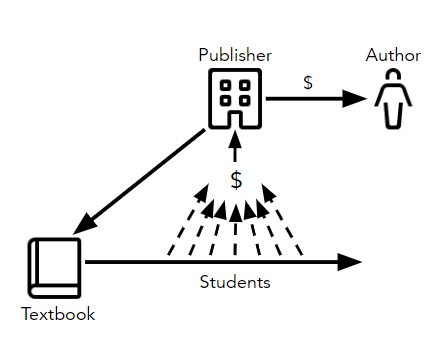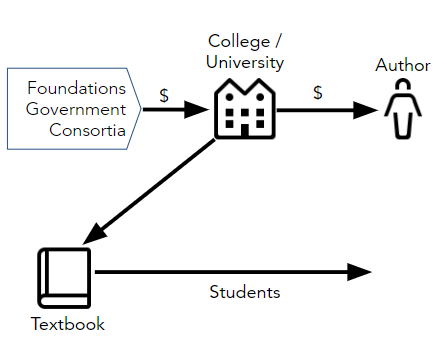Publishing Models
To understand how OER publishing works, it is helpful to understand how the traditional textbook publishing model works.
In the traditional textbook publication tends to follow this basic process. First, a publisher invests in publishing a textbook. Students buy the books, which allows the publisher to make enough money to cover their initial investment as well as a profit. Lastly, the publisher pays royalties to the author, typically a single-digit percentage of total revenue. The graphic below demonstrates that model:

The open publishing model has a few key differences. First, a college or university publishes a textbook. They might put out a call for proposals to their faculty, such as the call put out by VCU Libraries through our Affordable Course Content Awards program. These projects are sometimes supported by outside funding from foundations, government, and consortia, but as the open movement matures, colleges and universities are increasingly deciding to self-fund these efforts. Faculty are often paid up front for their work to contribute to these textbooks. Because the project funding is not related to sales of the book, universities are able to distribute these textbooks for free and to make them available to be freely shared, copied, remixed, etc.

It’s important to note that depending on the maturity of the publishing program and the resources of the institution, the publishing process itself could be exactly the same in the two models, including peer review, copy editing, and other professional-level production services. This is contrary to the myth that all OER are of poor quality or do not pass the same standards of rigor of traditional textbooks.
This open model also has the potential to address inequities in traditional publishing models. In a time when there is, for example, growing legislation to ban educators from talking about certain topics (i.e. critical race theory), traditional textbook publishers feel financial pressure to bend to these bans. This has led to some books published by major publishers to focus only on certain stories or historical narratives.
Open publishing allows for more flexibility in whose stories are told and who is involved in telling those stories, offering the opportunity to amplify diverse voices and create resources that are reflective of a wide range of identities and lived experiences.
Key Takeaways
- The traditional textbook publishing model and the open publishing model’s primary differences are that the traditional model relies on revenue from sales to students, while the open model relies on funding from institutions in order to distribute the textbooks for free to students.
- Both models can yield quality textbooks!
Adapted from “Access, Affordability, Inclusion, and Academic Success: Intro to OER Adoption Workshop.” by the Open Education Network, available under CC BY 4.0.

